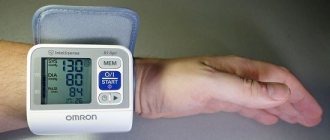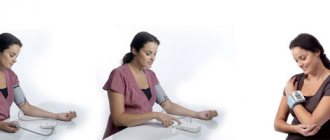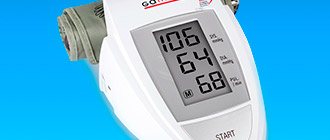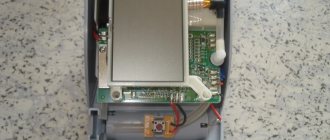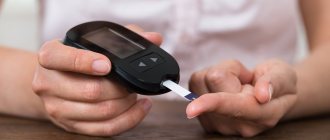Regular pressure surges bring a lot of problems and force you to react sensitively to changes occurring in the body. But is it worth calling a doctor at the first manifestations of hypertension or hypotension? Is it possible to limit ourselves to home methods of measuring blood pressure (blood pressure)? Today in pharmacies you can purchase easy-to-use and accurate tonometers that allow you to measure systolic and diastolic pressure at home. How to correctly measure pressure with an automatic or semi-automatic device and what to consider before diagnosing?
On which hand should I measure and in what position?
Blood pressure shows how hard the blood presses against the walls of the arteries. To determine indicators, there are standardized boundaries that indicate the state of human health. They are reduced to two digits of the upper and lower values. They indicate the level of pressure when the heart valve closes, the heart relaxes, and the pulse at the wrist.
For this, a special device is used - a tonometer. Not everyone knows how to use a tonometer correctly. Let's look at the step-by-step instructions below.
As a rule, blood pressure is measured in the upper part of the forearm of the right or left hand, but it is worth clarifying that the indicators may vary. To determine the hand that is best to use, the pressure is measured on both limbs with a break of several minutes. Each reading is entered into the table, and after 10-12 measurements, all minimum values are eliminated. The hand on which higher values were established reflects the correct results.
Posture is also important. If a person is not a bedridden patient, then it is preferable to measure blood pressure while sitting. In this case, the legs should be relaxed, not crossed, the body should be leaned on the back. To get accurate results, you need to relax and sit quietly in this position before the procedure. The cuff of the device should be located at heart level.
How do electronic devices work?
The main difference between the semi-automatic model is in its design - during manual pumping, blood pressure readings are performed automatically, that is, by an electronic device.
Devices for measuring pressure consist of a display, a pneumatic chamber in a fabric shell and an air blower. The semi-automatic tonometer is equipped with a pear-shaped pump; air is pumped manually. The measurement is carried out automatically, the data is displayed on the display. The heart rate is also displayed there. The design of the device and ease of use allows you to measure systolic and diastolic blood pressure at home. To control blood pressure levels, it must be measured regularly (at least once every 7 days), at one time with one tonometer.
How does a tonometer work?
The operating principle of the device is based on the oscillometric method of determining blood pressure, which consists in capturing short-term pressure surges in the pneumatic chamber caused by arterial pulsation. Information about changes in pressure in the pneumatic chamber caused by pulsation of the artery is captured and processed by an electronic device built into the body. The air blower, cuff and pressure gauge are connected by hoses.
Modern models of semi-automatic tonometers are equipped with a number of necessary and useful functions. The device takes three measurements automatically and displays the average in less than 2 minutes. The functions of detecting pulse arrhythmia are irreplaceable. The artificial intelligence system eliminates the possibility of measurement errors in arrhythmia. The devices are equipped with memory for storing data, a calendar, a clock, measurement quality control systems and battery saving systems.
Advantages of semi-automatic tonometers for measuring blood pressure
Advantages of the device.
A semi-automatic blood pressure meter has several advantages. Semi-automatic blood pressure monitors with a shoulder cuff are considered the most accurate. The absence of an electric compressor pumping air reduces the risk of breakdown and significantly extends the service life of the device. The advantages also include the good price/quality ratio of semi-automatic tonometers.
Disadvantages of using a semi-automatic machine
If blood pressure is monitored by older people or patients with musculoskeletal disorders, manually pumping air into the pneumatic chamber using a bulb can be difficult. In such cases, it is better to purchase an automatic tonometer. Perhaps this is the only factor that is considered a disadvantage of semi-automatic tonometers.
How often can measurements be taken?
If you have heart disease, patients are interested in questions about how to properly use a semi-automatic or automatic tonometer, and how often they need to measure blood pressure. For those who have to regularly carry out the procedure, devices with automatic cuff inflation are more suitable.
At home, blood pressure is measured 2-3 times a day:
- The first time in the morning, an hour after waking up. Before this, you must avoid drinking coffee and tea, do not smoke or exercise.
- The second time the measurement is carried out in the evening, observing the listed requirements.
- The pressure is measured a third time if there are headaches or malaise.
It is not recommended to carry out the procedure more often, as this may weaken the blood vessels and distort the accuracy of the results.
How to choose a tonometer?
People often have difficulties choosing a semi-automatic blood pressure monitor. After all, the market now offers a huge number of different models, both basic and with additional functions, both budget and expensive.
It is recommended to pay attention to the following points when choosing a meter:
- Measurement accuracy. This is the most important criterion that must be checked directly in the store.
- Cuff size. Mostly, tonometers are produced with standard cuffs, but more advanced options can be found.
- Build quality. You also need to pay attention to how the device is assembled. All parts must be secured in place and as securely as possible.
- Price. Saving on a blood pressure monitor is not the best solution. It’s better to spend more money, but provide yourself with a high-quality and accurate meter for many years, than to save money and throw the device in the trash after a couple of years.
- Availability of additional functions. If you need some useful options, then you can choose a multifunctional tonometer. But it will always be more expensive than the basic one.
- Manufacturer. Preference should be given to well-known companies that have been producing blood pressure monitors for a long time and are very popular.
It is also worth checking whether the device’s operating instructions have been translated into Russian if the tonometer was manufactured abroad.
Older people should choose a device with a large screen and numbers, as well as sound signals. This will make the measurement process more comfortable for users of this age.
Electronic automatic tonometer
Measuring blood pressure with different devices has some nuances.
How to use an electronic tonometer:
- the hand must be freed from clothing and a cuff placed on it;
- the hand should be stationary at the level of the heart;
- then press the “Start” button;
- After a while, the results will appear on the screen.
To find out the average value, it is necessary to re-test after 5 minutes.
Semi-automatic blood pressure monitor
You can measure your blood pressure with a semi-automatic tonometer yourself at home.
How to use a semi-automatic blood pressure monitor:
- put a cuff on the arm 3-5 cm above the elbow, secure it with Velcro;
- using a pear-shaped pump, pump air to a value 30-40 mmHg higher than the expected reading;
- then gradually release air at a rate of 2 mmHg per second.
From 3 to 5 measurements are taken on each arm to establish more accurate readings. In the intervals between procedures, it is necessary to bend and unclench the limb several times for better blood circulation. From the data obtained, the average is calculated and recorded in a notebook.
How to use correctly
Correct installation and removal of indicators is possible if the sequence of actions is followed.
Mechanical
The difficulty lies in the fact that the use of the device is designed for two people: the patient and the doctor. The results change constantly - it depends on physical activity, stress and other reasons.
To obtain the correct pressure readings, first of all, bring the state into balance within 10 minutes.
- Place the cuff on the forearm of your left hand at the level with your heart (this is 1 cm above the bend of the elbow joint).
- Fasten with Velcro on the arm, slightly obliquely, since the arm is wider closer to the shoulder joint.
- A round acoustic head for listening to beats is installed on the bend of the elbow joint or 1 cm above it at the place where the brachial artery passes. It passes through the area that is closer to the body, 1-1.5 cm from the center of the elbow. The location of the stethoscope above the elbow will be convenient when independently measuring blood pressure, since it will be clamped and adhered to by the lower edge of the cuff. Place ear tips with soft rubber tips in your ears to listen to impacts.
- On the top of the bulb there is a valve for regulating air flow - it closes and air is pumped into the cuff, without being able to escape back. To check the indicator, the cuff is inflated 40 divisions higher than the expected result. The valve is opened by turning it in the opposite direction a small fraction so that the air comes out slowly.
- The first (upper pressure) indicator will be reflected by a loud “hooting” of heartbeats. It is remembered, and the point when the loud sounds stop is the lower blood pressure value.
After use, the valve opens and air escapes completely from the cuff.
Inflating air into the cuff with a bulb is also used in the semi-automatic model of the tonometer, but the stethoscope is not included in the kit. The indicators are displayed on the display of a plastic recorder.
Measuring blood pressure with a mechanical tonometer
Semi-automatic
They trust the results obtained not in the old way using a technical device, but in new automatic and semi-automatic devices. To take measurements correctly, follow the sequence:
- sit close to the table;
- Put a cuff on your forearm at the level with your heart (place your half-bent arm on the table);
- place the connected recorder so that you can clearly see the display;
- turn on the “start” button, after the signal and the “up” arrow appears, inflate the air into the cuff to a value 40 notches higher than the expected result;
- if the arrow does not disappear, pump it up another 20 indicators;
- put the pear on the table - the smart device will “do” the further actions itself;
- write down the digital indicators;
- if an icon appears in the arrhythmia window, next to the results, enter “A”;
- do not remove the cuff until the air is completely released, which is done using the valve on the bulb.
If the device is not completely freed from air, the device will not show the following measurements.
Electronic
The electronic model is similar to a semi-automatic device, but does not have a bulb, and manual inflation is not used - air is pumped into the cuff automatically. The sequence of measurements is the same as in the semi-automatic model.
The main condition is a free arrangement of the wires, the air tube lies parallel to the hand. After measurements, write down the result, turn off the device, free your hand.
On the wrist
You can easily and reliably get results by measuring your blood pressure yourself using a device on your wrist. A popular model is the automatic wrist blood pressure monitor. The principle of operation is similar to the previous types: air is pumped in, the area with arterial blood flow is compressed, pressure fluctuations are recorded by the device and displayed on the display.
The accuracy of the readings depends on the sensitive microprocessor. The order of measurements is as follows:
- a tonometer is placed on the left wrist behind the bone;
- raise the measuring device to the level of the heart;
- When the meter is turned on, the display will show the result after 30 seconds.
The device has a built-in function for saving data. The operation of the medical device model is convenient for measuring blood pressure in old age. Since the structure of vascular tissue changes with age, only a hypersensitive microprocessor will “feel” pressure fluctuations.
A popular and popular device in the form of different models is produced by OMRON. Automatic and semi-automatic blood pressure monitors are presented with different measurement locations: both on the forearm and on the wrist.
Wrist blood pressure monitor
Mechanical tonometer
Measuring pressure with a mechanical device is the most difficult. It is important to approach the process very carefully and monitor the readings on the device.
How to use a mechanical tonometer:
- You need to relax before the procedure. If you come into the house from the cold, you need to warm up.
- It is necessary to take a sitting position, relax your legs and not cross them. Place your hands on a flat surface at heart level and keep motionless.
- A cuff is placed on the arm, the lower edge of which should be just above the elbow. The tonometer dial should be in front of your eyes to monitor the readings.
- Using a hand pump, inflate the cuff with air. The stethoscope is placed on the bend of the elbow, and the heartbeat should be clearly audible.
- The air begins to be gradually released until a tone appears, this is the upper (systolic) pressure. After the tones disappear, the reached mark on the dial will indicate the lower (diastolic) pressure.
- After a couple of minutes, the procedure is repeated, the average indicator most accurately indicates blood pressure. In case of possible heart rhythm disturbances, it is better to entrust the procedure to a healthcare professional.
Which blood pressure monitor should you choose?
Before choosing a device for measuring blood pressure, you should understand the range of devices offered by medical equipment manufacturers. These are electronic and semi-automatic machines. Each device has its own advantages. It is believed that a semi-automatic device is characterized by greater accuracy, as close as possible to mechanical devices.
An automatic machine that pumps air by pressing buttons is easier to use if you measure it yourself. It is better to use a semi-automatic tonometer with an assistant, since when inflating the bulb you perform physical activity on your own, which can affect the accuracy of the device’s readings.
All compact devices that measure blood pressure are equipped with monitors that, in addition to diastolic and systolic pressure, display heart rate. The numbers from previous measurements remain in the device’s memory, which allows you to monitor the dynamics of the patient’s condition. Measuring pressure with an automatic tonometer is extremely simple and does not require medical skills. The device itself knows perfectly well how much air to pump into the cuff.
Important! If the person’s normal blood pressure is unknown, the bulb is pumped up to 200 mmHg. Art. If data on habitual blood pressure are known, 40 mm Hg is added to the upper pressure reading. Art. and stop the pumping process.
How to measure wrist pressure?
A tonometer that allows you to measure pressure on the wrist is in great demand among hypertensive patients. The device is portable, has a modern design and stores all blood pressure indicators for a long time.
How to use a wrist blood pressure monitor:
- The tonometer is placed on the arm with the display facing up. There should be a gap of 1 cm from the bottom edge of the bracelet to the palm. There is no need to tighten the strap too much, but the bracelet should fit evenly to the hand.
- The patient takes a comfortable position and places his hand in front of him at heart level. Then you need to even out your breathing and relax. The device is activated; you cannot move during the measurement.
Typically, blood pressure readings measured at the wrist are slightly higher than those obtained from the same procedure at the forearm. Manufacturers of devices do not hide this and explain it by the specific location of the arteries on the wrist and their width.
Cuff selection
Tonometers are semi-automatic and many automatic ones are equipped with a cuff made of synthetic material, which is attached to the shoulder with Velcro. The accuracy of blood pressure measurements depends on the choice of the size of this element of the device. The same device will not be able to correctly measure the pressure of a teenager and a large elderly person due to the difference in the thickness of the arm.
The optimal size is determined by measuring the thickness of the arm above the elbow. Are there several people in the family who require regular blood pressure monitoring? Today you can purchase a cuff that will fit as closely as possible, separately.
The recommendations are as follows:
- if the shoulder circumference is from 22 to 26 cm, the size of the canvas should be 22x12 cm;
- for a hand with a circumference of 27–34 cm, a cuff whose dimensions are 16x30 cm is suitable;
- a cuff of 16x36 cm is relevant for patients whose shoulder circumference is 35–44 cm;
- the largest cuff size – 16x42 cm – is designed for people whose arm circumference is 45 cm or more.
Advice! Some manufacturers supply the medical equipment market with devices equipped with a frame cuff that allows you to measure blood pressure for a person of any age and size.
Devices with a cuff that attaches to the wrist are also popular. This solution is recommended for use by people under 50 years of age and not suffering from severe hypertension or complicated hypotension. The age range is due to the fact that the vessels of the wrist begin to undergo atherosclerotic changes quite early. The device should not be used if the wrist has been previously injured, as the result may be inaccurate.
Tonometers with a wrist cuff are convenient to take with you and can be used to monitor your condition when playing sports, etc.
Why are the results different?
We looked at how to use a mechanical tonometer and an automatic analogue. Often a person has a question about the veracity of testimony.
The following factors may affect the correctness of blood pressure measurements:
- The electronic tonometer was used near household appliances (computer, microwave oven) that emit electromagnetic waves.
- During the measurement process, actions can be performed that are not a load for a person, but they are reflected in the resulting indicator - coughing, laughter, changing posture, hand movements.
- Before performing the procedure, the patient did not calm down; any emotions affect blood pressure.
- During the procedure, it is likely that the air pressure in the cuff will change. This is due to pressure on it, intermittent breathing, and active movement of the leg.
- The patient took an incorrect position during blood pressure measurement. Lying down, the upper pressure reading increases, and the lower reading decreases. When sitting cross-legged or without leaning on the back, the pressure level increases.
- The limb on which the cuff is placed must lie on the surface. If the hand is unsupported, both values increase.
- The cuff is not secured correctly.
- The arm on which the pressure is measured is located above or below the level of the heart.
- If a couple of hours before the procedure the patient smoked or drank coffee, the blood pressure increases to ten units.
- The pressure must be measured up to 5 times in a row on the same arm, and if you do not maintain an interval of several minutes between measurements, the result will be inaccurate.
If a person has purchased such a device for the first time, it is better to consult with a medical professional and find out how to use the tonometer.
Recommendations for measuring blood pressure
There are a number of certain rules, breaking which you cannot count on the accuracy of the tonometer readings. It is not difficult to follow them; it is only important to get used to a certain scheme of working with the device and stick to it.
- Automatic or semi-automatic measurement always starts with a 5-minute rest.
- Before measuring your blood pressure, you should go to the toilet.
- An hour before the procedure, you should not drink coffee or strong tea, smoke, or undergo intense physical activity. Failure to comply with this rule will lead to significant errors in the operation of the device.
- It is important to sit as straight as possible, leaning against the back of the chair and placing your hand on a flat surface.
- Feet should be level on the floor. You cannot cross them.
- When measuring blood pressure with a device attached to the wrist, you can not only sit, but also stand. It is only important to keep your hand in the heart area. If you raise it higher or lower it, the numbers may be too high or too low.
- You should not talk or gesture while measuring blood pressure with an automatic or semi-automatic tonometer.
- The sleeves of the garment should be rolled up to ensure maximum contact with the cuff.
- To obtain the most reliable information about blood pressure, it is worth measuring it on both arms with an interval of 1–2 minutes. The difference is 10 mm Hg. st is normal. On which hand the pressure is traditionally higher, it is preferable to choose it during subsequent measurements.
- If pressure is measured with a semi-automatic device, then the bulb is inflated to 40 mmHg. Art. higher than expected.
Advice! Before measuring your blood pressure yourself, you should consult with your doctor, who can recommend the optimal number of measurements and help you understand the functional features of the device. Don’t forget to watch the video that is available on the Internet, which will allow you to get additional tips on the operation of a particular device.
Recommendations
Often people do not know how to use a manual blood pressure monitor or a semi-automatic device. Let's look at some recommendations:
- People over 40 years of age are recommended to purchase automatic blood pressure monitors; devices on the wrist will not accurately reflect the readings, since the arteries in this area are quite worn out in older people.
- For patients suffering from cardiovascular diseases, it is better to purchase a tonometer that measures not only blood pressure, but also pulse.
- If the device is used by two family members, you should pay attention to models that store the data of two users.
- A tonometer with a fan-shaped cuff does not cause discomfort during use; it fits tightly to the arm, as a result of which blood pressure readings are not distorted.
- The cuff must not be secured over clothing or the device must be turned on until it is worn.
- During the procedure, you should not talk or strain.
- For people with poor vision, tonometers have been developed that pronounce the measurement results, and devices with an intelligent control function are also commercially available. Thanks to special sensors, they give a signal if the procedure is performed incorrectly.
In the article we looked at how to use a tonometer. It is worth saying that the correctness of the noted indicators depends on the correct use of the device. If a person is in doubt, then it is necessary to talk with a doctor and clarify the nuances of using a tonometer.
Additional functions of devices
When purchasing a device for measuring blood pressure, you should pay attention to the availability of additional functions. Among the most useful of them are the following:
What do upper and lower pressure mean?
- PAD technology – the ability to diagnose pulse arrhythmia;
- MAM technology – calculation of the average value of three consecutive blood pressure measurements;
- diagnostics according to the WHO scale;
- increased memory capacity;
- timer;
- clock and calendar;
- battery saving system;
- the possibility of sound notification of diagnostic results, relevant for people with poor vision.
When purchasing, you should pay attention not only to the functionality of the device, but also to its accuracy. The accuracy class must be confirmed by clinical studies, as evidenced by the inscription “The highest accuracy class is confirmed by clinical studies” or “Clinically validated”.
No ads 1
